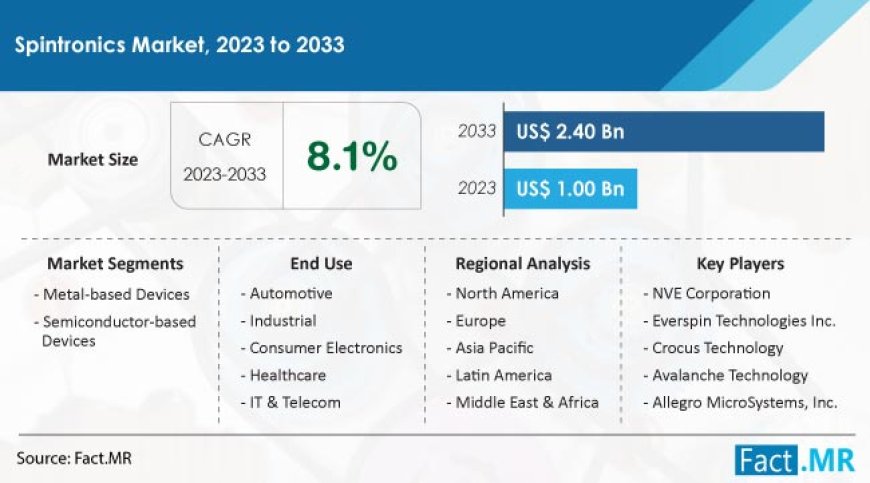Worldwide Spintronics Market Demand is set to Reach a Valuation of US$ 2.4 Billion By 20233

As per the detailed industry report by Fact.MR, a market research and competitive intelligence provider, the global spintronics market is predicted to soar at a CAGR of 8.1% and reach a valuation of US$ 2.4 billion by 2033.
Spintronics, sometimes referred to as spin electronics or magneto electronics, is a developing technology that processes and stores data by using the spin of electrons. In comparison to conventional electronic devices, spintronic devices have several benefits, including low power consumption, high speed, and non-volatility, making them ideal candidates for the future generation of electronic devices.
Get Free Sample Copy of This Report: https://www.factmr.com/connectus/sample?flag=S&rep_id=8734
Spintronic circuit boards could take the place of transistors based on spintronics. One of the newest areas of nanotechnology, spintronics, has experienced rapid expansion. Spintronics offers the potential for faster and more energy-efficient devices compared to traditional electronics, making it an attractive solution for various applications, such as computer processors, memory devices, and sensors.

One of the main drivers propelling market expansion is the rising demand for hybrid and electric vehicles (EVs) across the globe. Spintronic closed-loop sensors are widely employed to precisely measure the battery’s remaining capacity and verify the charge and discharge states to enhance an automobile’s overall efficiency.
Several technological advancements such as the development of spin transistors based on semiconductors and the incorporation of linked devices with the Internet of Things (IoT), are fostering market expansion. The market is set to rise as a result of many other reasons, such as the expanding deployment of 5G technology, particularly in developing economies, and intense research and development (R&D) efforts.
For industrial automation, process control, and more extensive industrial IoT applications, spintronic sensors are employed. Additionally, sensors are used in a variety of industrial applications for rotation, linear and angular position detection, and current sensing.
Key Takeaways from Market Study
The global spintronics market stands at a value of US$ 1 billion in 2023.
Worldwide demand for spintronics is set to increase at a CAGR of 8.1% from 2023 to 2033.
The market is forecasted to reach a revenue of US$ 2.4 billion by 2033.
Semiconductor-based devices are dominating the global market with 40% share.
North America accounts for 35% share of the global market in 2023.
Key Companies Profiled in Report
NVE Corporation
Everspin Technologies Inc.
Crocus Technology
Avalanche Technology
Allegro MicroSystems, Inc.
Spin Memory Inc.
IBM Corporation
Plures Technologies
Intel Corporation
Rhomap Ltd.
Advanced MicroSensors, Inc.
Get Customization on this Report for Specific Research Solutions:
https://www.factmr.com/connectus/sample?flag=RC&rep_id=8734
Winning Strategy
Rapid digitalization has led to the creation of new business models in the corporate, governmental, retail, and e-Commerce sectors. Businesses are providing customers with more complete digital experiences. As a result, there is a considerable demand for high-speed spintronic data storage systems.
Leading companies are concentrating on the utilization of advanced materials, low-power electronics, and miniaturization. Top manufacturers should seize incremental chances in spintronics technology to boost their income streams.
For instance,
In 2019, High-field TMR magnetic switch was introduced by NVE Corporation. It can respond to magnetic fields in all directions.
More Valuable Insights on Offer
Fact.MR, in its new offering, presents an unbiased analysis of the global spintronics market, presenting historical demand data (2018 to 2022) and forecast statistics for the period (2023 to 2033).
The study divulges essential insights on the spintronics market based on product (metal-based devices, semiconductor-based devices), application (electric vehicles, industrial motors, data storage, magnetic sensing), and end use (automotive, industrial, consumer electronics, healthcare, IT & telecom), across five major regions of the world (North America, Europe, Asia Pacific, Latin America, and MEA).

 swatichaudhari
swatichaudhari 










